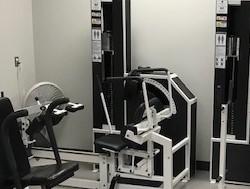Overcoming The Mental Hurdle of Muscular Failure - by Matthew Romans
Posted May 31, 2019 by Matthew RomansThe word "failure" naturally has a negative connotation. In most other walks of life, failure is synonymous with not getting the job done, coming up short, or simply not being good enough. All of us have experienced failure in one form or another in our lives, and even though it has been said that we learn far more from our failures than our successes, the mere idea of the word failure is something that is unpleasant to most of us. At Total Results, we view the word failure in a completely different light. In the context of a high-intensity strength training workout, achieving momentary muscular failure means success.
Pushing to and beyond momentary muscular failure can do a psychological number on many of us in a couple of ways. First, the idea of no longer being able to move the machine's movement arm can be startling. Second, the burning that you feel in your muscles as exercise intensity increases (what we often call exertional discomfort) is often uncomfortable and unpleasant to deal with. This is why we proceed slowly in the first several sessions with new clients; in addition to teaching proper form and speed, finding proper settings in the machines, and mastering turnaround technique, we want clients to gradually get used to the discomfort that is a byproduct of intense exercise. We want to prepare you for the arrival of momentary muscular failure so that you are physically and psychologically ready to handle it. The ability to keep emotions in check and maintain focus as the exercise becomes more demanding is one of the most important skills a trainee can develop.
Why is achieving momentary muscular failure so important? Remember that the workout itself is merely the stimulus; the improvements that we seek occur as a result of maximizing recovery between sessions, getting enough sleep, hydrating and eating properly, and managing stress. Pushing to and beyond muscular failure ensures that we have done all that we can to stimulate the body, and it is also important from a standpoint of maintaining insulin sensitivity by flushing out the glycogen (stored carbohydrate) from the muscle cells. There are only two tangible measurements of muscular effort, zero and 100. Zero effort will not stimulate any benefits, and while we still do not know what the specific percentage of effort is required for optimum stimulus, we are safe in assuming that a maximum effort (going to muscular failure) will get the job done.
What can you do to overcome this hurdle? I'm reminded of a phrase that our colleague Al Coleman once used: "don't run from the discomfort, chase after it." The fear of exertional discomfort is often far worse than the discomfort itself. While the discomfort is unpleasant it is brief, lasting no more than three minutes, and once you accept the fact that the discomfort is inevitable it is easier to deal with. Try also to understand that the primary objective of each exercise is not to move the weight or complete a certain number of repetitions, but rather to inroad the musculature. Don't focus on whether the weight is moving or not; instead, focus on breathing freely and pushing against the movement arm, especially as movement slows or even stops. Muscular failure can come on suddenly or occur gradually; sometimes you'll know it's coming a repetition or two before it happens, and other times it feels like you've hit a wall. I can't explain exactly why this happens, but it can vary from one person or exercise to the next. The important thing is to not give into one's instincts when things get tough.
Arthur Jones once said that exercise begins at failure. While it's very natural to experience some distress upon reaching muscular failure, sharpening your mental focus when the exercise becomes most difficult will help you to achieve the optimal exercise stimulus. At Total Results, failure is success!

